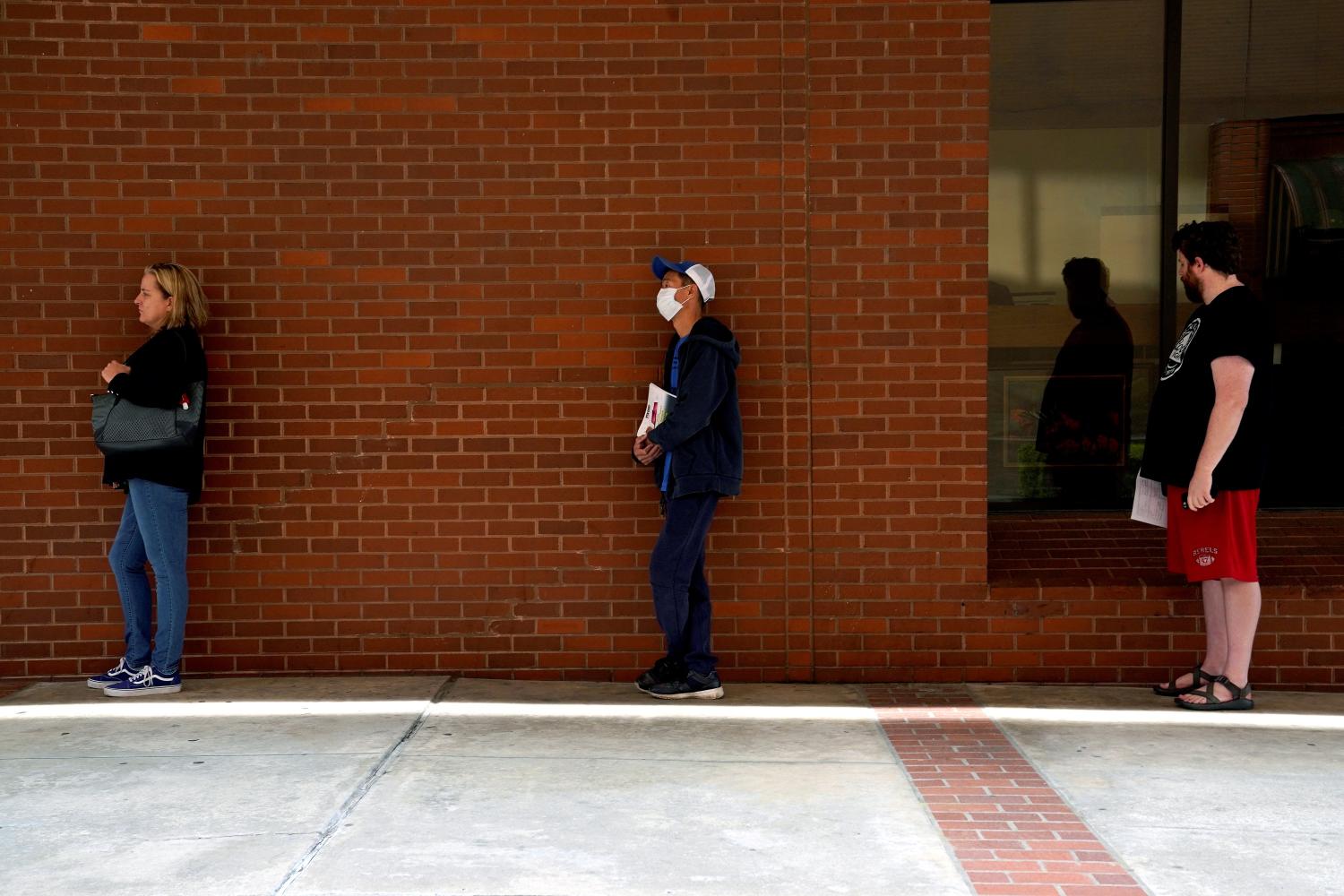Register now for the upcoming webinar, Addressing widespread closures in the retail and hospitality industries, on April 9, 2020 from 2:00 to 3:00 PM EST.
As states and municipalities across the country go on lockdown to prevent the spread of COVID-19, state unemployment websites have experienced unprecedented spikes in unemployment claims, totaling over 10 million in the past two weeks alone. To put that in context, at the peak of the Great Recession, state agencies were managing about 665,000 claims in a week.
One of the unique features of this crisis is that it is disproportionately impacting low-wage workers in the service sector more than previous recessions. This problem is being compounded by the fact that our unemployment system has been engineered to be less equipped to protect these workers. Many states were forced to borrow federal money to bail out their unemployment insurance (UI) trust funds in the wake of the Great Recession and responded by tightening eligibility requirements for UI, lowering benefit levels, and reducing benefit durations.
By the time COVID-19 broke out, UI funding and staffing levels were at an all-time low. State UI systems disproportionately excluded those who were new to the labor force, not consistently employed full time in the previous year, or whose incomes were too low to meet income thresholds. Essentially, UI systems tended to exclude exactly the types of workers this pandemic is affecting the most.
Now that these workers are, in many cases, legally mandated not to work in order to protect public health, Congress created three new UI programs, all slated to last for less than a year. Although this level of support for displaced workers is unprecedented, the already-overloaded state UI agencies will also have to implement these changes as soon as possible to get money in the hands of residents.
Millions of jobless Americans are facing the harsh reality that the systems they thought would be there in a time of need are all jammed up. In this brief, we explain how UI typically worked before the pandemic, how federal legislation temporarily reformulates UI to respond to this crisis, and what opportunities the pandemic may open up for building a more functional UI safety net in the future. Our focus is workers in the food and beverage industry, a critical sector for urban economies, as well as a source of employment for over 12 million Americans.
What unemployment insurance typically does for low-wage service sector workers
The COVID-19 pandemic has laid bare some gaping holes in our national safety net, especially when it comes to state UI systems and their inadequacy to meet the needs of the most affected workers in a pandemic. The Coronavirus Aid, Relief, and Economic Security (CARES) Act, signed on March 27, completely overhauls the normal procedures for states to decide who is eligible for UI and how much money displaced workers receive—on a temporary basis. This section outlines how UI typically works and why Congress had to radically restructure it in the midst of this crisis.
UI is a state-run system with federal oversight, so the system and rules vary considerably from one state to another. UI is funded through a tax on employers, and each employer receives an experience rating that determines the rate at which they need to pay into the system, based on their record of laying off workers.
After the Great Recession, 36 states had to take out interest-bearing loans to continue paying out benefits. The main strategy that states used to cope with low UI trust fund balances was to tighten eligibility requirements and scale back benefits. As a result, UI has consistently covered fewer and fewer unemployed workers, leaving a disproportionate number of people of color, part-time workers, caregivers, low-wage workers, and younger workers behind.
 Note: The new federal relief legislation, the CARES Act, temporarily changes #1 by creating the Pandemic Unemployment Assistance program that covers workers who normally would not qualify for UI in their state. It adds qualifying reasons to #2 to allow for COVID-19-related situations to qualify. It also gives states flexibility of waiving requirements for #3 and #4 during the pandemic to protect public health.
Note: The new federal relief legislation, the CARES Act, temporarily changes #1 by creating the Pandemic Unemployment Assistance program that covers workers who normally would not qualify for UI in their state. It adds qualifying reasons to #2 to allow for COVID-19-related situations to qualify. It also gives states flexibility of waiving requirements for #3 and #4 during the pandemic to protect public health.
Until the coronavirus pandemic, most states excluded gig workers, freelancers, caregivers, and the self-employed from access to UI. Undocumented immigrants are also categorically ineligible. In addition, 27 states exclude full-time students from UI, a reality that has hurt many students working in service sector jobs. Most states also require an individual to have earned income for at least six months in their state to be eligible, which excludes people who recently entered or reentered the workforce.
Income thresholds. To qualify for UI, an individual must meet minimum earnings levels in the “base period,” which is roughly equivalent to the prior year. In many states, individuals who have experienced several months of unemployment in a given year or only worked part time are likely to be disqualified for this reason. This presents a disadvantage for those who were not consistently attached to the labor market in the last year, including many students, low-wage workers, parents, people with minor disabilities, or formerly incarcerated people. Because of occupational segregation patterns and labor market discrimination, these requirements also tend to disproportionately exclude women and people of color.
Part-time service workers were likely to experience difficulty meeting state income thresholds under the regular UI system. Meanwhile, the hospitality sector has by far the highest staff turnover rates of any industry (78.8% annually as of 2019), meaning that those workers are significantly more likely to be new to their job and could be disqualified from UI because they do not meet the income or job tenure requirements in their state (especially if the new job was preceded by an episode of unemployment).
Reduced wage-replacement levels. Even when someone meets the above eligibility requirements, the benefit itself tends to be quite small, only replacing 36% of the average weekly earnings of production and nonsupervisory workers in 2019. Tipped workers are especially likely to receive benefits that are much lower than their regular take-home pay, because of underreporting of tips (the Treasury Department estimates that employers do not report 52% of tips). We also found that many of the highest-cost areas of the country had very low benefits (see table below).
Many of the highest-cost metro areas had very low UI benefit levels before coronavirus
| State | Metro area (Regional Price Parity Rank, 2017) |
Max. weekly benefit level, 2020 (Approx. monthly equivalent) |
Average weekly benefit level, Q4 2019 (Approx. monthly equivalent) |
| California | San Jose (#1), San Francisco (#2), Santa Cruz (#3), Napa (#5), Santa Rosa (#6), Vallejo (#8), Oxnard (#11), Los Angeles (#13 – tie), San Diego (#13 – tie) |
$450 ($1,800) |
$338 ($1,353) |
| Hawaii | Honolulu (#4) |
$648 ($2,592) |
$533 ($2,133) |
| New York | New York (#7) |
$504 ($2,016) |
$385 ($1,542) |
| Connecticut | Bridgeport (#9) |
$649 ($2,596) |
$414 ($1,658) |
| District of Columbia | Washington (#10) |
$444 ($1,776) |
$363 ($1,454) |
| Washington | Seattle (#14 – tie) |
$790 ($3,160) |
$491 ($1,966) |
| Massachusetts | Boston (#14 – tie) |
$823 ($3,292) |
$555 ($2,222) |
Sources: High-cost metro areas: Bureau of Economic Analysis, 2017. Maximum UI benefit levels: U.S. Department of Labor (USDOL), 2020. Average UI benefit levels: USDOL, 2019.
Declining duration of benefits. Another way that several states attempted to replenish their UI trust funds after the Great Recession was to reduce the length of time that a claimant could receive benefits. Most states allow up to 26 weeks, but states such as Florida and North Carolina allowed only 12 weeks when unemployment rates were low.
 Note: Some states increased benefit durations prior to the CARES Act in response to the pandemic, and the CARES Act expanded benefit durations for 13 weeks until December 31, 2020.
Note: Some states increased benefit durations prior to the CARES Act in response to the pandemic, and the CARES Act expanded benefit durations for 13 weeks until December 31, 2020.
Meanwhile, states have yet to fully replenish their UI trust funds after the Great Recession. As of January 2019, there was substantial variance in the balances on these accounts, with the most populous states running closest to the red. Of the 21 states under the recommended minimum solvency level, all are on stay-at-home orders for all but essential workers. Most states, in fact, are not ready for the wave of unemployment claims descending on them, and state administrators will need more emergency financial relief.
Top 10 states and territories with UI trust funds most unprepared to cover a surge in unemployment
| State or territory |
Solvency level, using the Average High Cost Multiple,* 2019 |
Share of workforce in leisure and hospitality |
| Virgin Islands | 0 | 14.6% |
| California | 0.21 | 11.7% |
| New York | 0.36 | 9.8% |
| Texas | 0.36 | 10.9% |
| Illinois | 0.42 | 10.2% |
| Massachusetts | 0.42 | 10.3% |
| Ohio | 0.42 | 10.3% |
| Connecticut | 0.50 | 9.3% |
| Indiana | 0.51 | 9.9% |
| West Virginia | 0.52 | 10.5% |
*Average High Cost Multiple: This measures how a state’s UI trust fund level compares to the average of the three highest historical levels (previous recessions).
Sources: Solvency levels: USDOL, 2020. Workforce share: Bureau of Labor Statistics, 2020
How have federal COVID-19 relief packages changed unemployment insurance?
So far, Congress has enacted two COVID-19 relief bills that affect the UI system in significant ways. On April 3, the Families First Coronavirus Response Act will go into effect. Families First provides $1 billion in emergency administrative funds to ensure states have basic UI processing and notification procedures in place and to implement expansions to their programs.
The recently passed CARES Act makes additional changes to the UI safety net (on a temporary basis) through three new federally funded programs. Key among CARES Act changes are:
- Gig workers, self-employed individuals, part-time workers, and other categories of workers that normally would be ineligible for UI will now qualify for Pandemic Unemployment Assistance (PUA) until the end of 2020.
- A $600 per week increase in benefit levels for both regular UI, partial UI, and PUA claimants to replace a higher share of their previous earnings until July 31, 2020.
- The addition of up to 13 weeks of benefits beyond the state’s preexisting limits on benefits duration, until December 31, 2020.
- Incentivizes states to use, adopt, and publicize Short-Time Compensation programs, which allow employers to avoid layoffs by reducing hours and workers to collect UI benefits for lost hours.
- Allows states to eliminate the one-week waiting period for receiving benefits.
Although these changes are justifiably generous under the circumstances, they will be very challenging for states to adapt quickly to when they are already overburdened with new unemployment claims. Most states have very outdated technology systems from the 1970s and 1980s that make implementing new rules and procedures difficult. The Pandemic Unemployment Assistance program, in particular, will be hard for states to implement quickly because of the complexity of managing the wide variety of ways that self-employed and gig workers receive and document their incomes. Realistically, it will take state agencies several weeks to implement these changes, and it is possible that some will take longer than a month.
Implementation of these changes may lead to confusion among workers about who is eligible and when their state is set up to accept applicants who normally would not qualify. Even pre-crisis, an estimated 23% of unemployed workers eligible for UI did not apply. In this moment, the best strategy for workers who have lost income, hours, or been laid off is to apply, even if they are unsure about eligibility—but only after their state UI agency announces they have updated their system for CARES Act changes. The Labor Department released official guidance for states to implement the CARES Act and created a coronavirus page to clarify this process. Each state’s unemployment agency website will have the latest official updates and information.
How to build a better safety net
The point of having a safety net is for something to be there to protect people in a moment of crisis, be it personal or global. To serve that function, these systems need to be robust enough to cover any worker and set up with automatic triggers so that a crisis doesn’t necessitate creating an entirely different set of policies, eligibility rules, benefit levels, and processes. Governors, mayors, and state agencies need to be able to deploy support quickly and efficiently in a crisis while minimizing confusion. Business owners and workers need to understand what forms of support they are entitled to in simple enough terms that they can make major decisions about how to respond.
The coronavirus has demonstrated that the U.S. needs a major overhaul and data system modernization effort for a wide range of safety net programs. This pandemic has made the weaknesses of the UI system obvious to many people, but they have long been a reality for displaced low-wage workers, part-time workers, people of color, or the long-term unemployed.
The following are high-level recommendations for where to start in a longer-term reform of our UI system:
- Ensure that every category of worker has permanent access to wage insurance in the event of an involuntary reduction of hours or layoff on a permanent basis, regardless of whether they are a gig worker, tipped worker, part-time worker, etc.
- Expand and publicize shared work programs which help minimize layoffs by allowing employers to reduce hours in response to temporary decreases in demand and compensate workers for lost hours with benefits.
- Increase the share of jobless workers who UI covers by making eligibility processes more consistent across states, lowering or eliminating the income thresholds for eligibility, and ensuring that all states offer at least 26 weeks of benefits.
- Prioritize improvements to the UI system that make it more user-friendly. For example, we could create a secure, government-owned software as a service (SaaS) form builder that any state could use to collect applicant information and avoid having their systems crash at high volumes.
- Continue to expand Reemployment Services and Eligibility Assessments (RESEA) grants, which provide early-intervention job search assistance and career counseling to those who are likely to exhaust their benefits.
- Strengthen the conditionality and expand access to career navigation assistance and retraining to support transitions back into the labor force through expansions to the core programs available under the Workforce Innovation and Opportunity Act of 2015 and the American Job Centers. Compared to other OECD countries, the U.S. invests much less in active labor market programs to support workers’ transitions back to work.
- Shore up the solvency of state UI trust funds, make the funding mechanisms more responsive to the level of unemployment, and remove the maximum tax cap for employer experience ratings so that the system functions more effectively to discourage layoffs.
- Conduct a thorough assessment of how UI data systems can be modernized and updated in a cost-effective manner, how state and federal procurement can be reformed to expedite this process, and how these systems can be continuously improved while safeguarding privacy.
Advocates and policy researchers have also proposed more detailed reforms, both pre-COVID-19 and post-COVID-19, including a UI reform toolkit. The OECD also found that the American UI system was relatively weak compared to other industrialized countries on several measures, and provided recommendations for strengthening it.
This moment of chaos presents an opportunity for clarity about what steps federal and state leaders must take to support and protect the U.S. workforce from market downturns in the long term. Both in times of crisis and not, American unemployment insurance needs to align with the value that low-wage and service workers bring to our local communities.








